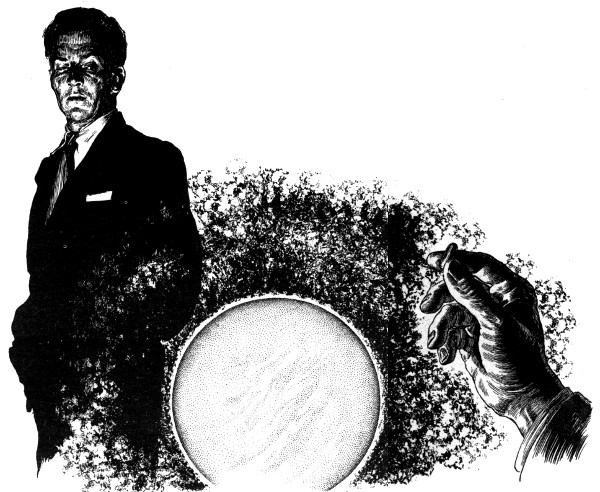
Advance Agent
By CHRISTOPHER ANVIL
Illustrated by FINLAY
[Transcriber's Note: This etext was produced from
Galaxy Science Fiction February 1957.
Extensive research did not uncover any evidence that
the U.S. copyright on this publication was renewed.]
Raveling Porcy's systematized enigma, Dan
found himself with a spy's worst break—he
was saddled with the guise of a famed man!
I
Dan Redman stooped to look in the mirror before going to see thedirector of A Section. The face that looked back wasn't bad, if he hadexpected strong cheekbones, copper skin and a high-arched nose. But Danwasn't used to it yet.
He straightened and his coat drew tight across chest and shoulders. Thesleeves pulled up above hands that felt average, but that the mirrorshowed to be huge and broad. Dan turned to go out in the hall and hadto duck to avoid banging his head on the door frame. On the way downthe hall, he wondered just what sort of job he had drawn this time.
Dan stopped at a door lettered:
A SECTION
J. KIELGAARD
DIRECTOR
A pretty receptionist goggled at him and said to go in. Dan opened theinner door.
Kielgaard—big, stocky, expensively dressed—looked up and studied Danas he came in. Apparently satisfied, he offered a chair, then took outa small plastic cartridge and held it in one hand.

"Dan," he said, "what do you know about subspace and null-points?"
"Practically nothing," admitted Dan honestly.
Kielgaard laughed. "Then I'll fill you in with the layman's analogy,which is all I know. Suppose you have a newspaper with an ant on themiddle of the front page. To get to the middle of page two, the anthas to walk to the edge of the paper, then walk back on the inside.Now suppose the ant could go through the page. The middle of pagetwo is just a short distance away from the middle of page one. Thatgoing through, instead of around, is like travel in subspace. Anda null-point is a place just a short distance away, going throughsubspace. The middle of page two, for instance, is a null-point for themiddle of page one."
"Yes," said Dan patiently, waiting for the point of the interview.
Kielgaard pushed the plastic cartridge he'd been holding through a slotin his desk. A globe to one side lighted up a cottony white, with faintstreaks of blue. "This," he said, "is Porcys."
Dan studied the globe. "Under that cloud blanket, it looks as if itmight be a water world."
"It is. Except for a small continent, the planet is covered with water.And the water is full of seafood—edible seafood."
Dan frowned, still waiting.
"Galactic Enterprises," said Kielgaard, "has discovered a region insubspace which has Porcys for one null-point and Earth for another."
"Oh," said Dan, beginning to get the point. "And Earth's hungry, ofcourse. Galactic can ship the seafood straight through subspace at abig profit."
"That's the idea. But there's one trouble." Kielgaard touched a button,and on the globe, the white layer vanished. The globe was a brilliantblue, with a small area of mingled green and grayish-brown. "The landarea of the planet is inhabited. Galactic must have the permission ofthe inhabitants to fish the ocean. And Galactic needs to